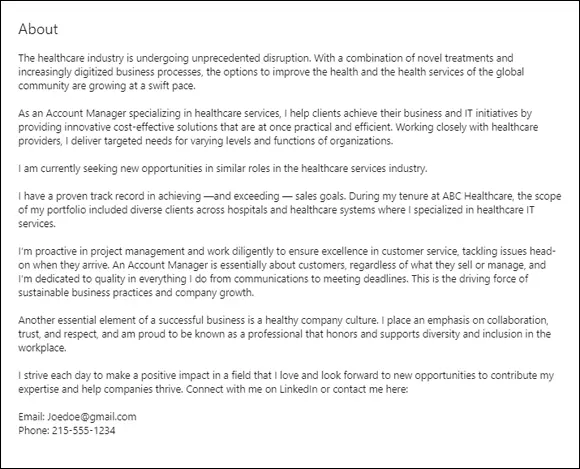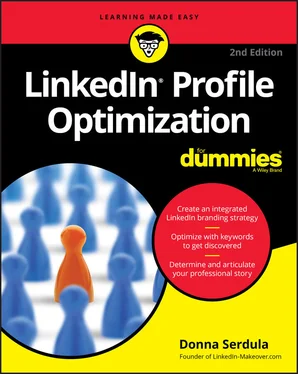In addition to what you’re reading now, this book also comes with a free access-anywhere Cheat Sheet that gives you even more pointers on how to optimize your LinkedIn profile. My favorite cheat sheet details how to take your LinkedIn profile photo yourself! To get this Cheat Sheet, simply go to www.dummies.com and search for LinkedIn Profile Optimization For Dummies Cheat Sheet in the Search box.
You can also visit my website for additional free resources like my LinkedIn Headline Generator, LinkedIn Text Formatter, Background Photo library, and more. Click the Free Resources tab at www.linkedin-makeover.com .
An optimized LinkedIn profile is more than just your online reputation. A powerfully written LinkedIn profile has the ability to change your life. After optimizing their profiles, I’ve seen people find amazing jobs and opportunities. They connect with more people and experience the full gamut of what LinkedIn and a successful career has to offer.
I wish you the very best of luck — now go get optimizing!
Part 1
The Strategy Before the Siege
IN THIS PART …
Understand your LinkedIn goals and target audience to give your profile purpose.
Learn how to use the proper tone in your profile to draw people in, not push them away.
Optimize your LinkedIn search results by discovering your keywords and infusing them throughout your profile.
Learn how to use LinkedIn as a search tool and how to ensure your search result listing catches a reader’s eye.
Add skills to showcase your strengths to potential employers or clients.
See why soliciting endorsements and endorsing others boosts your credibility.
Chapter 1
Determining Your LinkedIn Strategy
IN THIS CHAPTER
 Deciding your LinkedIn goal
Deciding your LinkedIn goal
 Understanding your target audience
Understanding your target audience
 Using the proper tone
Using the proper tone
When you register for a LinkedIn account, the first thing you encounter is the LinkedIn profile. Most people jump in and immediately fill out the fields of the profile, not giving much thought as to why they are on LinkedIn or who will eventually be reading their profile.
Profiles created without a goal or a target audience in mind lack purpose. These profiles don’t catch readers’ eyes and compel them to reach out to the person behind the online persona. You see these profiles on LinkedIn every day. Scanning the profile, nothing grabs you or makes you want to learn more about that person.
To experience success on LinkedIn, you must approach your LinkedIn profile strategically. In this chapter, I show you how to determine your LinkedIn strategy by looking at the three most typical goals people are trying to accomplish on LinkedIn. Once you’ve determined your goal, I show you how to figure out your target audience and discuss the importance of creating a compelling profile tone.
Determining Your LinkedIn Goal
To create a profile that has purpose, you must ask yourself, “What am I trying to accomplish on LinkedIn?” Many people get a LinkedIn account because they want to find a new job. Other people are interested in reputation management and branding. Still other people are on LinkedIn because they are in sales and want to prospect and increase sales through social selling.
To help you determine what you want your profile to accomplish, review the following three most common types of LinkedIn profiles.
LinkedIn plays a huge role in the job search process. Recruiters, hiring managers, and human resources professionals search LinkedIn looking for potential candidates. They may perform broad-based keyword searches looking for a candidate who matches the skill sets the position requires, or they may already have certain candidates in mind. When they have a person already in mind for a position, a name search is performed on LinkedIn with the goal of learning more about that person than what is stated on his or her resume.
LinkedIn is also a job board. The LinkedIn Jobs section ( www.linkedin.com/jobs ) is where thousands of jobs from all over the world are posted. These job postings are promoted throughout LinkedIn as well. When you find a job posting that interests you, you can apply for the position by submitting your resume and LinkedIn profile.
 Even if you aren’t utilizing LinkedIn’s job postings or hoping to collide with a recruiter, potential employers are still looking you up on LinkedIn and reviewing your LinkedIn profile. Think about it: If you are about to hire someone, and available to you is a database in which to look this person up and see a picture of the candidate, a listing of people he or she knows, and recommendations of his or her work ethic, of course you would use it!
Even if you aren’t utilizing LinkedIn’s job postings or hoping to collide with a recruiter, potential employers are still looking you up on LinkedIn and reviewing your LinkedIn profile. Think about it: If you are about to hire someone, and available to you is a database in which to look this person up and see a picture of the candidate, a listing of people he or she knows, and recommendations of his or her work ethic, of course you would use it!
Potential employers are looking at your profile. The good news is you have control over how you represent yourself and how they perceive you. A job search profile complements and echoes your resume without being a direct one-to-one copy. The profile is written to the job description of that next position you are targeting and showcases you as the perfect candidate for that role. See Figure 1-1 for an example.
To find out more about how to create a powerful job search profile, see Chapter 11.

FIGURE 1-1:A job search profile.
Reputation management and branding
It’s a Google world. At one time, if you needed to find out information, you headed to the library to search the encyclopedias and other reference materials. Now, all you need to do is pull up a web browser and perform an Internet search to get more information than you could ever read or use.
This easy access to information has some side effects. People are doing more research than ever before and they are researching you! Going to the doctor? Most people search the Internet for the doctor’s name to see the results that pop up in a search engine. Executives who find their names appearing in press releases or in magazine articles may find that views to their LinkedIn profiles skyrocket by readers wanting to know more about them.
Job candidates’ names are entered into search engines all the time by hiring managers looking to discover more than what is provided in the resume. Similarly, hiring managers’ names are searched by job candidates wanting to learn more about their potential new employer.
LinkedIn profiles rank high in search results. Not only is it usually the top result when a person searches for your name, but also it’s sometimes the only result, as most people don’t have a personal website. You create your LinkedIn profile. You choose what people learn about you. You have total control over how people perceive you. A reputation management profile is one that showcases your successes, honors, awards, and accomplishments, and leads people to see you as a credible, impressive professional.
Читать дальше

 Deciding your LinkedIn goal
Deciding your LinkedIn goal Even if you aren’t utilizing LinkedIn’s job postings or hoping to collide with a recruiter, potential employers are still looking you up on LinkedIn and reviewing your LinkedIn profile. Think about it: If you are about to hire someone, and available to you is a database in which to look this person up and see a picture of the candidate, a listing of people he or she knows, and recommendations of his or her work ethic, of course you would use it!
Even if you aren’t utilizing LinkedIn’s job postings or hoping to collide with a recruiter, potential employers are still looking you up on LinkedIn and reviewing your LinkedIn profile. Think about it: If you are about to hire someone, and available to you is a database in which to look this person up and see a picture of the candidate, a listing of people he or she knows, and recommendations of his or her work ethic, of course you would use it!











